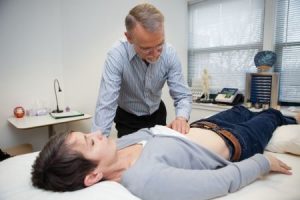Last week we talked about how holistic medicine can help older patients. But a review of 31 different published articles as old as 2008 has shown that acupuncture is relatively effective with low risk in pediatric cases as well.
“A lot of kids are medication-sensitive, and acupuncture doesn’t have the side effects of medication,” explains Cleveland Clinic Children’s Hospital physical medicine and rehabilitation specialist Benjamin Katholi, MD.
Therefore, acupuncture may be a good solution for children suffering from a wide range of mental or physical problems.
Shakuju Therapy for children
Image above: The hand of Kobayashi Sensei who founded Shakuju Therapy
The review doesn’t mention use of non-invasive or insertive styles of acupuncture like I practice. Read my blog post on Shakuju Therapy and needles used to learn about how successful acupuncture does not necessarily require the needles to actually puncture the skin.
One of the reasons I like this style of acupuncture is that I find it equally effective while being a “gentler” treatment. Often, I’ve been told that Shakuju Therapy just feels like a light tapping. That’s why, unlike with other styles of acupuncture treatment, I feel comfortable treating infants and young children.
Is acupuncture effective for kids?
Yes! A 2015 study from Rush University Medical Center in Chicago recruited 55 children and teens who’d been “miserable for months with chronic pain and gave them up to eight 30-minute treatments. Every one of these kids reported having significantly less pain after receiving acupuncture. The greatest reductions came right away, after the first few sessions, but their pain continued dwindling throughout the trial. They didn’t have any adverse side effects from the treatments either, except feeling slightly tired after a session,” (not a bad thing…many of my patients report feeling so relaxed that they nod off on the table while being treated or nap afterwards). “Their parents also noticed big improvements in their children’s moods, social lives, and ability to focus at school.”
How is an acupuncture treatment for adults different than that of children?
Specific acupuncture points on the body are the same between children and adults. However, like with most medical treatments, children are more sensitive and respond quicker to acupuncture treatments in my experience.
Therefore, the biggest difference in treatment between adults and children is that children require milder and less acupuncture stimulation and often see more immediate results. In addition, pediatric acupuncture that I perform on the very young doesn’t involve any needle insertion at all. My approach varies from using a Teishin needle to specific pediatric tools for gentle stimulating energetic pathways on the body.
Perhaps there’s no reason for children to be afraid of needles, anymore!

